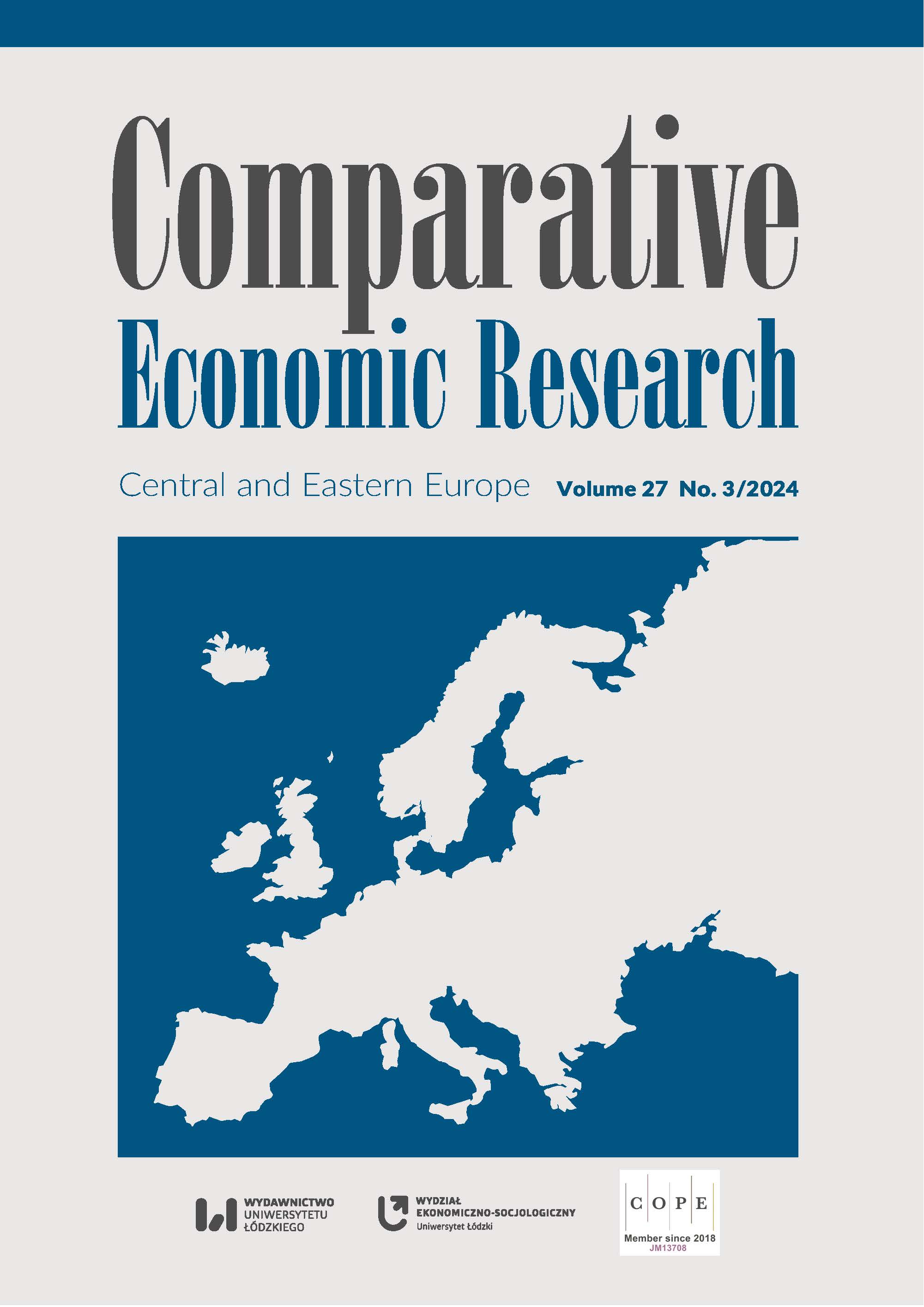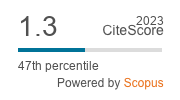Consumer and Professional Inflation Expectations – Properties and Mutual Dependencies
DOI:
https://doi.org/10.18778/1508-2008.27.23Keywords:
inflation expectation, mutual information, dynamic time warpingAbstract
Inflation expectations are a crucial variable for central banks. However, empirically examining their properties is challenging. This paper juxtaposes the properties of consumer and professional expectations. It also assesses the degree of forward- and backward-lookingness and the information content of expectations. We apply entropy-based measures (common information and mutual common information) to capture nonlinear dependencies and dynamic time warping to account for different lags in the relationships. The study covers 12 inflation-targeting economies from the European region. The results suggest that in most countries, professionals are more forward-looking, and consumers follow professionals. Both groups of economic agents present expectations that are aligned in terms of information content. However, cross-country differences occur. These results imply that, from the central bank’s point of view, communication and practices designed to shape expectations, even if understood mostly by specialists, are effective also for consumers. The novelty of this study lies in its use of alternative methods to tackle the formation and dependencies between heterogeneous expectations. This avoids the drawbacks of a standard approach and allows broader conclusions to be drawn.
Downloads
References
Abildgren, K., Kuchler, A. (2021), Revisiting the inflation perception conundrum, “Journal of Macroeconomics”, 67, 103264, https://doi.org/10.1016/j.jmacro.2020.103264
Google Scholar
Batchelor, R.A., Orr, A.B. (1988), Inflation Expectations Revisited, “Economica”, 55 (219), pp. 317–331, https://doi.org/10.2307/2554010
Google Scholar
Będowska-Sójka, B., Kliber, A., Rutkowska, A. (2021), Is Bitcoin Still a King? Relationships between Prices, Volatility and Liquidity of Cryptocurrencies during the Pandemic, “Entropy”, 23 (11), 1386, https://doi.org/10.3390/e23111386
Google Scholar
Binder, C. (2015), Whose expectations augment the phillips Phillips curve?, “Economics Letters”, 136, pp. 35–38, https://doi.org/10.1016/j.econlet.2015.08.013
Google Scholar
Carlson, J.A., Parkin, M. (1975), Inflation Expectations, “Economica”, 42 (166), pp. 123–138, https://doi.org/10.2307/2553588
Google Scholar
Carroll, C.D. (2003), Macroeconomic Expectations of Households and Professional Forecasters, “The Quarterly Journal of Economics”, 1 (118), pp. 269–298, https://doi.org/10.1162/00335530360535207
Google Scholar
Coibion, O., Gorodnichenko, Y. (2015), Is the Phillips Curve Alive and Well after All? Inflation Expectations and the Missing Disinflation, “American Economic Journal: Macroeconomics”, 7 (1), pp. 197–232, https://doi.org/10.1257/mac.20130306
Google Scholar
Coibion, O., Gorodnichenko, Y.R.K. (2018), The Formation of Expectations, Inflation, and the Phillips Curve, “Journal of Economic Literature”, 56 (4), pp. 1447–1491, https://doi.org/10.1257/jel.20171300
Google Scholar
D’Acunto, F., Hoang, D., Paloviita, M., Weber, M. (2019), Cognitive Abilities and Inflation Expectations, “AEA Papers and Proceedings”, 109, pp. 562–566, https://doi.org/10.1257/pandp.20191050
Google Scholar
Dionisio, A., Menezes, R., Mendes, D.A. (2004), Mutual information: a measure of dependency for nonlinear time series, “Physica A: Statistical Mechanics and its Applications”, 344 (1–2), pp. 326–329, https://doi.org/10.1016/j.physa.2004.06.144
Google Scholar
Dobrushin, R. (1963), General formulation of Shannon’s main theorem in information theory, [in:] A.A. Andronov, D.V. Anosov, Ding Shia-shi, R.L. Dobrušin, G.V. Gil’, A.N. Kolmogorov, E.A. Leontovič, A.D. Myškis, O.A. Oleĭnik, S.L. Sobolev, V.M. Staržinskiĭ, Eleven Papers in Analysis: Nine Papers on Differential Equations, Two on Information Theory, “American Mathematical Society Translations”, 33, pp. 323–438, https://doi.org/10.1090/trans2/033/11
Google Scholar
Dovern, J., Fritsche, U., Slacalek, J. (2012), Disagreement Among Forecasters in G7 Countries, “The Review of Economics and Statistics”, 94 (4), pp. 1081–1096, https://doi.org/10.1162/REST_a_00207
Google Scholar
Drager, L. (2015), Inflation perceptions and expectations in Sweden – Are media reports the missing link?, “Oxford Bulletin of Economics and Statistics”, 77 (5), pp. 681–700, https://doi.org/10.1111/obes.12078
Google Scholar
El Amouri, H., Lampert, T., Gançarski, P., Mallet, C. (2023), Constrained DTW preserving shapelets for explainable time-series clustering, “Pattern Recognition”, 143, 109804, https://doi.org/10.1016/j.patcog.2023.109804
Google Scholar
European Commission (2016), The Joint Harmonised EU Programme of Business and Consumer Survey. User guide, Brussels.
Google Scholar
Evans, G., Gulamani, R. (1984), Tests for rationality of the Carlson-Parkin inflation expectations data, “Oxford Bulletin of Economics and Statistics”, 46 (1), pp. 1–19, https://doi.org/10.1111/j.1468-0084.1984.mp46001001.x
Google Scholar
Ferreira, J., Morais, F. (2023), Predict or to be predicted? A transfer entropy view between adaptive green markets, structural shocks and sentiment index, “Finance Research Letters”, 56, 104100, https://doi.org/10.1016/j.frl.2023.104100
Google Scholar
Franses, P.H., Wiemann, T. (2020), Intertemporal Similarity of Economic Time Series: An Application of Dynamic Time Warping, “Computational Economics”, 56, pp. 59–75, https://doi.org/10.1007/s10614-020-09986-0
Google Scholar
Gerberding, C. (2001), The Information Content of Survey Data on Expected Price Developments for Monetary Policy, “Economic Research Centre of the Deutsche Bundesbank”, 9, pp. 30–52, https://doi.org/10.2139/ssrn.2785125
Google Scholar
Hahn, J., Hausman, J., Kuersteiner, G. (2004), Estimation with weak instruments: Accuracy of higher-order bias and MSE approximations, “The Econometrics Journal”, 7 (1), pp. 272–306, https://doi.org/10.1111/j.1368-423X.2004.00131.x
Google Scholar
Han, T., Peng, Q., Zhu, Z., Shen, Y., Huang, H., Abid, N.N. (2020), A pattern representation of stock time series based on DTW, “Physica A: Statistical Mechanics and its Applications”, 550, 124161, https://doi.org/10.1016/j.physa.2020.124161
Google Scholar
Lahmiri, S., Bekiros, S. (2020), Renyi entropy and mutual information measurement of market expectations and investor fear during the COVID–19 pandemic, “Chaos, Solitons & Fractals”, 139, https://doi.org/10.1016/j.chaos.2020.110084
Google Scholar
Lucas Jr., R.E. (1972), Expectations and the neutrality of money, “Journal of Economic Theory”, 4 (2), pp. 103–124, https://doi.org/10.1016/0022-0531(72)90142-1
Google Scholar
Lucas Jr., R.E. (1976), Econometric policy evaluation: A critique, “Carnegie-Rochester Conference Series on Public Policy”, 1, pp. 19–46.
Google Scholar
Łyziak, T. (2013), Formation of Inflation Expectations by Different Economic Agents, “Eastern European Economics”, 51 (6), pp. 5–33, https://doi.org/10.2753/EEE0012-8775510601
Google Scholar
Łyziak, T., Mackiewicz-Łyziak, J. (2014), Do Consumers in Europe Anticipate Future Inflation?, “Eastern European Economics”, 52 (3), pp. 5–32, https://doi.org/10.2753/EEE0012-8775520301
Google Scholar
Łyziak, T., Sheng, X.S. (2023), Disagreement in Consumer Inflation Expectation, “Journal of Money, Credit and Banking”, 55 (8), pp. 2215–2241, https://doi.org/10.1111/jmcb.12981
Google Scholar
Martens, E.P., Pestman, W.R., Boer, A. de, Belitser, S.V., Klungel, O.H. (2006), Instrumental Variables: Application and Limitations, “Epidemiology”, 17 (3), pp. 260–267, https://doi.org/10.1097/01.ede.0000215160.88317.cb
Google Scholar
Muth, J.F. (1961), Rational Expectations and the Theory of Price Movements, “Econometrica: Journal of the Econometric Society”, 29 (3), pp. 315–335, https://doi.org/10.2307/1909635
Google Scholar
Raihan, T. (2017), Predicting US Recessions: A Dynamic Time Warping Exercise in Economics, “SSRN Electronic Journal”, https://doi.org/10.2139/ssrn.3047649
Google Scholar
Rakthanmanon, T., Campana, B., Mueen, A., Batista, G., Westover, B., Zhu, Q., Zakaria, J., Keogh, E. (2012), Searching and mining trillions of time series subsequences under dynamic time warping, [in:] Proceedings of the 18th ACM SIGKDD International Conference on Knowledge Discovery and Data Mining, Beijing China August 12–16, 2012, pp. 262–270, https://dl.acm.org/doi/10.1145/2339530.2339576
Google Scholar
Rutkowska, A., Szyszko, M. (2022), New DTW Windows Type for Forward- and Backward-Lookingness Examination. Application for Inflation Expectation, “Computational Economics”, 59 (2), pp. 701–718, https://doi.org/10.1007/s10614-021-10103-y
Google Scholar
Staiger, D., Stock, J.H. (1994), Instrumental variables regression with weak instruments, “Technical Working Paper”, 151, National Bureau of Economic Research, Cambridge, https://doi.org/10.3386/t0151
Google Scholar
Stock, J.H., Wright, J.H. (2000), GMM with Weak Identification, “Econometrica”, 68 (5), pp. 1055–1096, https://doi.org/10.1111/1468-0262.00151
Google Scholar
Wyner, A.D. (1978), A definition of conditional mutual information for arbitrary ensembles, “Information and Control”, 38 (1), pp. 51–59, https://doi.org/10.1016/S0019-9958(78)90026-8
Google Scholar
Zhao, Y. (2022), Internal consistency of household inflation expectations: Point forecasts vs. density forecasts, “International Journal of Forecasting”, 39 (4), pp. 1713–1735, https://doi.org/10.1016/j.ijforecast.2022.08.008
Google Scholar
Downloads
Published
How to Cite
Issue
Section
License

This work is licensed under a Creative Commons Attribution-NonCommercial-NoDerivatives 4.0 International License.
Funding data
-
Narodowym Centrum Nauki
Grant numbers 2020/37/B/HS4/02611











